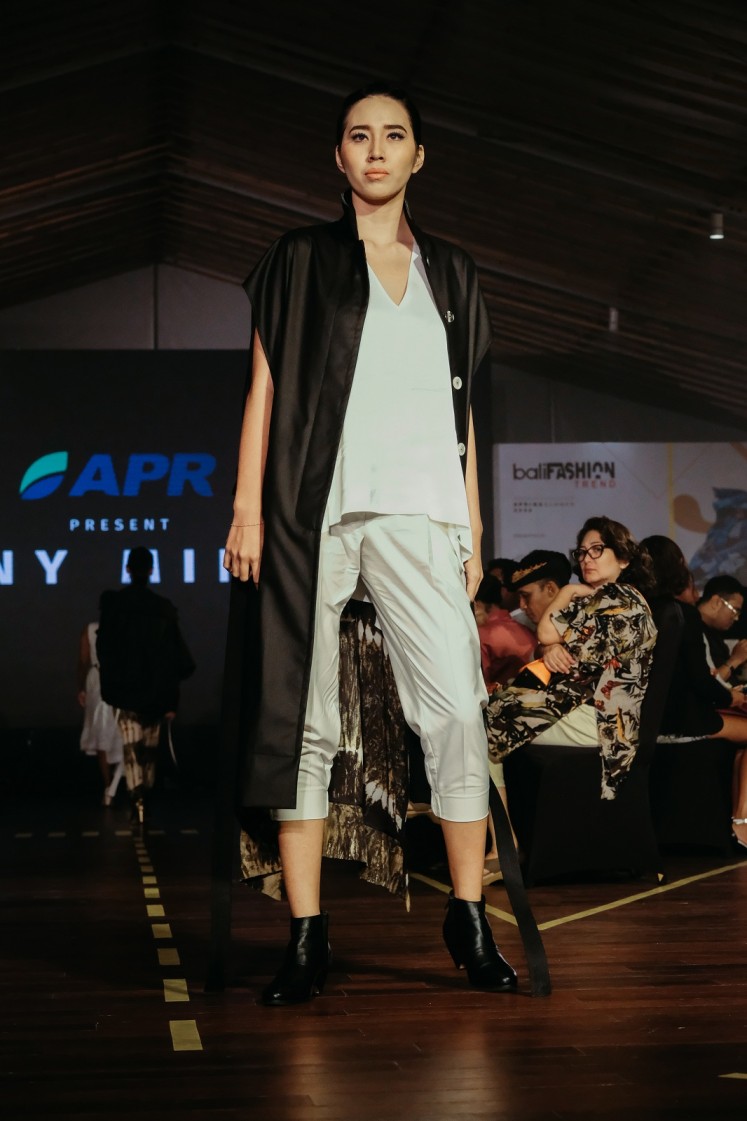Popular Reads
Top Results
Can't find what you're looking for?
View all search resultsPopular Reads
Top Results
Can't find what you're looking for?
View all search resultsViscose may give Indonesia's textile industry edge in sustainability
Viscose, the third most commonly used fiber in the world, has been hailed as a sustainable alternative to oil-based synthetic textiles such as polyester, acrylic, nylon and spandex.
Change text size
Gift Premium Articles
to Anyone
S
aid to be the second-largest polluter in the world, right behind the oil industry, the harmful impacts of the fashion industry, which is valued at around $2.4 trillion and employs more than 75 million people worldwide, are staggering.
According to the UN Alliance for Sustainable Fashion, launched in mid-March, the industry is not only the second-biggest consumer of water, but also responsible for 8 to 10 percent of global carbon emissions – more than all international flights and maritime shipping combined.
The fact that fashion consumers on average buy "60 percent more pieces of clothing than 15 years ago", generating up to 92 million tons of trash, equivalent to 4 percent of the world’s waste each year, add more havoc to these impacts.
However, as people are becoming more eco-conscious, the global fashion industry has been joining the trend, leading to increasing demand for sustainable clothing materials.
Viscose, the third-most commonly used fiber in the world, has been hailed as a sustainable alternative to oil-based synthetic textiles such as polyester, acrylic, nylon and spandex.
Introduced in the late 1800s as an alternative to silk, the plant-based fiber, also known as rayon, is inexpensive to make and applicable in many ways, including for casual wear items, denim, socks, bed linen, towels, face masks and wet wipes.
Viscose fabric wrinkles easily and may shrink when washed, but it boasts great qualities as well, including being soft, smooth, lightweight and breathable, featuring excellent color retention and absorbency, draping well and being versatile by blending nicely with other fibers.
However, viscose's eco-friendly reputation is not always in line with manufacturers' sustainable practices, which highlights the need to ensure traceability, sustainable sourcing, responsible manufacturing and labor rights.
According to a report by the Guardian, some viscose manufacturers in China, India and Indonesia that are linked to major fashion brands were found to have been using toxic chemicals to produce the viscose from wood pulp, causing "severe environmental damage" to their surroundings.
One Indonesian company is determined to maintain a good reputation, though.
Part of diversified business group Royal Golden Eagle (RGE), founded by conglomerate Sukanto Tanoto, Asia Pacific Rayon (APR) claims to be "the first integrated fiber manufacturer in Indonesia that has the capabilities to produce viscose based on wood derived from sustainably-managed plantations", with trees being harvested within five years for the next cycle of planting and harvesting.
Targeting both domestic and international markets, the company's production across the entire value chain -- from raw materials to resources, technology and design creation – takes place in the country.
"We're just a 'baby', [established] only 10 months [ago]. [However], we're already exporting to around 14 countries, including Bangladesh, Pakistan, Turkey and Germany. Our buyers also come from Indonesian regions, such as East Java and Central Java," said Asia Pacific Rayon director Basrie Kamba during a press conference in Bali on Nov. 7.
Globally, China leads the market of viscose fiber producing countries, with India and Indonesia following behind in second and third position, respectively.
Highlighting "everything Indonesia" as its tagline, APR sources its renewable fiber from its own eucalyptus and acacia plantations in Pangkalan Kerinci subdistrict of Pelalawan regency, Riau, which is then processed at its own viscose mill located in the same area.
Commissioned on Dec. 1, 2018, the company's viscose mill named APR Kerinci boasts an annual capacity of 240,000 tons. Plans are in store to develop a yarn-spinning mill in 2020.
"Up to 4 million people are currently working in Indonesia’s textile industry," said Basrie. "As sustainable fashion gets global attention, [hopefully] viscose can become an alternative as well as the future textile material; [to] realize the dream of making Indonesia one of the world's textile and fashion powers."
During the Bali Fashion Trend event held on the island from Nov. 7 to 9, two of the 35 designers who showcased their works on the catwalk are collaborating with APR to feature a total of 16 items made from viscose.
Thirty-nine-year-old Eny Ming, who has a boutique on Jl. Legian, Bali, said viscose added a softer touch to her designs, though the smooth texture also posed as a challenge for her to maintain her style's character.
Meanwhile, Savira "Sav Lavin" Lavinia, 27, who presented her debut collection at Indonesia Fashion Week 2015, said that, though it was her first time using APR products, she had previously used viscose in her designs, mostly by combining it with other fabrics.
"I actually find sustainable fashion an interesting issue and started conducting research on it since 2016. I've stayed with the locals in Bena village in Ngada regency, East Nusa Tenggara, where I learned the process of things like natural dyeing and hand-woven tenun; [skills that] were passed down from our ancestors. Afterward, I became more eager to get involved in creating sustainable designs, which is not as easy as people might think," Sav said during an interview on Nov. 7.
As a market that is still dominated by polyester, Indonesian consumers are said to still consider comfort, style and price of clothes before taking into account the materials and the sustainability of production.
Regarding pricing, Basrie said viscose was as affordable as cotton or polyester. Meanwhile Eny considers viscose's soft and comfortable texture selling points that may help attract customers.
"Allowing designers to share their perspectives and meanings behind their collections may also help increase awareness on sustainable fabric," said Sav, "so that the public will become aware that fashion design isn't merely about aesthetics but also going through many processes."













